by Bruce Wells | Oct 6, 2025 | This Week in Petroleum History
October 6, 1886 – Natural Gas fuels Glass Manufacturing –
A 900-foot-deep natural gas well in a cornfield near Kokomo, Indiana, led to the establishment of the Indiana Natural Gas Company, and in 1888, the Opalescent Glass Works, which has been in continuous operation since. The state’s first natural gas well was completed in 1867, seeking oil reserves (see Indiana Natural Gas Boom).

Opalescent Glass Works won a gold medal at the 1889 Exposition Universelle in Paris for its “natural gas process” glass. Photo courtesy Kokomo Opalescent Glass.
Opalescent Glass Works, today Kokomo Opalescent Glass, almost went bankrupt when natural gas supplies dwindled, but in 1893 it recovered by selling electric insulators to Edison General Electric Company — and thousands of pounds of stained glass to Tiffany studios in New York City.
October 6, 1957 – Society of Petroleum Engineers established
The first board of directors meeting of the Society of Petroleum Engineers (SPE) established the professional society in an expansion of the American Institute of Mining, Metallurgical and Petroleum Engineers (AIME), which had created a Petroleum Division in 1922.
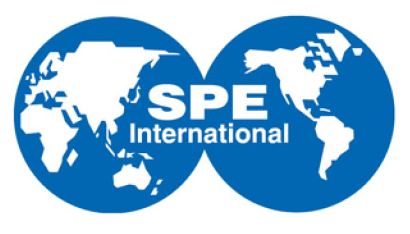
An American Institute of Mining Engineers program led to the Society of Petroleum Engineers.
AIME began in 1871, when a small group of Pennsylvania mining engineers sought to “preserve their collective knowledge and experiences for the benefit of future engineers.” SPE has grown into an independent, nonprofit global society with 132,000 members in 146 countries.
October 7, 1859 – First U.S. Oil Well catches Fire
The wooden derrick and engine house of America’s first oil well erupted in flames along Oil Creek at Titusville, Pennsylvania. The well had been completed the previous August by Edwin L. Drake for George Bissell and the Seneca Oil Company of New Haven, Connecticut. Working with driller William “Uncle Billy” Smith, Drake used steam-powered cable-tool technology.
The first U.S. oil well fire began when Uncle Billy inspected a vat of oil with an open lamp. When the lamp’s flame set gases alight, the conflagration consumed the derrick, the stored oil, and the driller’s home. Drake and Seneca Oil Company would quickly rebuild at the already famous well site.
Learn more in First Oil Well Fire.

October 7, 2014 – 200th Anniversary of Ohio Oil Discovery
The Noble County Historical Society of Caldwell, Ohio, hosted a 200th anniversary festival and park dedication celebrating a brine well drilled with a spring pole that produced oil. The 1814 well can be found at Thorla McKee Park, named for Silas Thorla and Robert McKee, the entrepreneurs who established the local salt works, according to researcher Dave Baker in “Early Marietta.”
In 2015, Baker reported the historic well site included the remains of its original sycamore log casing beneath a replica springpole. Thoria and McKee separated the oil from the salt water by soaking it up with blankets before bottling it to sell as a medicinal potion. The remaining brine was boiled to extract the salt. In 1992, the Noble County Department of Tourism and the Ohio Historical Society dedicated a historic marker near the Caldwell site. Ohio’s first well drilled exclusively for oil was completed near Macksburg in the autumn of 1860.
October 8, 1915 – Elk Basin oilfield discovered in Wyoming
An exploratory well drilled in a remote Wyoming valley opened the giant Elk Basin oilfield. Completed by the Midwest Refining Company near the Montana border, the wildcat well produced 150 barrels of high-grade “light oil” a day. The oil needed little refining to provide quality lubricants.

“Gusher coming in, south rim of the Elk Basin field, 1917.” Photo courtesy American Heritage Center, University of Wyoming.
Geologist George Ketchum first recognized the potential of the basin as a source of oil deposits. Ketchum had explored the remote area in 1906 with C.A. Fisher while farming near Cowley, Wyoming. The Elk Basin extended from Carbon County, Montana, into northeastern Park County, Wyoming.
Fisher was the first geologist to map sections of the Bighorn Basin southeast of Cody, Wyoming, where oil seeps had been found as early as 1883. The Wyoming oilfield discovery in unproven territory attracted new ventures like Elk Basin United Oil Company, investors, and oilfield service companies.
Learn more in First Wyoming Oil Wells.

October 8, 1923 – First International Petroleum Exposition and Congress
Five thousand visitors attended the rainy opening day of the first International Petroleum Exposition and Congress in downtown Tulsa, an event that would return for almost six decades.

Although still a tourist attraction, the 76-foot-tall Golden Driller arrived decades after Tulsa’s first International Petroleum Exposition in 1923.
With annual attendance growing to more than 120,000, Mid-Continent Supply Company of Fort Worth introduced the original Golden Driller of Tulsa at the expo in 1953. Economic shocks beginning with the 1973 OPEC oil embargo depressed the industry, and after 57 years, the International Petroleum Exposition ended in 1979.
October 9, 1999 – Converted Offshore Platform launches Rocket
Sea Launch, a Boeing-led consortium of companies from the United States, Russia, Ukraine, and Norway, launched its first commercial rocket using the Ocean Odyssey, a modified semi-submersible drilling platform. After a demonstration flight in March, a Russian Zenit-3SL rocket carried a DirecTV satellite to geostationary orbit.
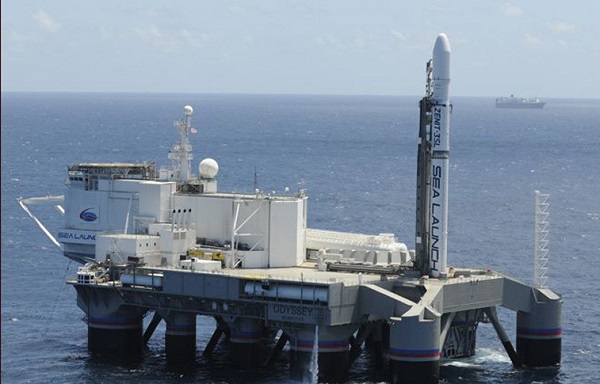
Ocean Odyssey, a modified semi-submersible drilling platform, became the world’s first floating equatorial launch pad in 1999. Photo courtesy Sea Launch.
In 1988, the former drilling platform had been used by Atlantic Richfield Company (ARCO) for North Sea explorations. The Ocean Odyssey made 36 more rocket launches until 2014, when the consortium ended after Russia illegally annexed Ukraine’s Crimean peninsula.
Learn more in Offshore Rocket Launcher.

October 10, 1865 – Oil Pipeline constructed in Pennsylvania
A two-inch iron pipeline began transporting oil five miles through hilly terrain from a well at booming Pithole, Pennsylvania, to the Miller Farm Railroad Station at Oil Creek. With their livelihoods threatened, teamsters attempted to sabotage the pipeline until armed guards intervened. A second oil pipeline would begin operating in December.
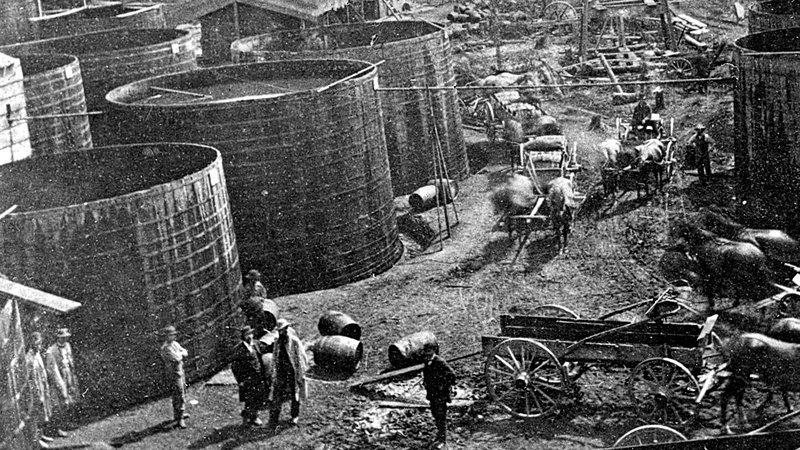
Oil tanks at the boom town of Pithole, Pennsylvania, where Samuel Van Syckel built a five-mile pipeline in 1865. Photo courtesy Drake Well Museum.
Built by Samuel Van Syckel, who had formed the Oil Transportation Association, the pipeline used 15-foot welded joints. Three 10-horsepower Reed and Cogswell steam pumps pushed the oil at a rate of 81 barrels per hour. With up to 2,000 barrels of oil arriving daily at the terminal, more storage tanks were soon added. The pipeline transported the equivalent of 300 teamster wagons working for 10 hours.
“The day that the Van Syckel pipeline began to run oil a revolution began in the business,” proclaimed Ida Tarbell in her 1904 History of the Standard Oil Company. “After the Drake well, it is the most important event in the history of the Oil Regions.”
_______________________
Recommended Reading: The Extraction State, A History of Natural Gas in America (2021); Myth, Legend, Reality: Edwin Laurentine Drake and the Early Oil Industry (2009); Where it All Began: The story of the people and places where the oil & gas industry began: West Virginia and southeastern Ohio
(2009); Where it All Began: The story of the people and places where the oil & gas industry began: West Virginia and southeastern Ohio (1994); Black Gold, Patterns in the Development of Wyoming’s Oil Industry (1997); Tulsa Where the Streets Were Paved With Gold – Images of America
(1994); Black Gold, Patterns in the Development of Wyoming’s Oil Industry (1997); Tulsa Where the Streets Were Paved With Gold – Images of America (2000); Offshore Pioneers: Brown & Root and the History of Offshore Oil and Gas
(2000); Offshore Pioneers: Brown & Root and the History of Offshore Oil and Gas (1997); Western Pennsylvania’s Oil Heritage
(1997); Western Pennsylvania’s Oil Heritage (2008); Oil and Gas Pipeline Fundamentals
(2008); Oil and Gas Pipeline Fundamentals (1993); Arizona Rocks & Minerals: A Field Guide to the Grand Canyon State
(1993); Arizona Rocks & Minerals: A Field Guide to the Grand Canyon State (2010). Your Amazon purchase benefits the American Oil & Gas Historical Society. As an Amazon Associate, AOGHS earns a commission from qualifying purchases.
(2010). Your Amazon purchase benefits the American Oil & Gas Historical Society. As an Amazon Associate, AOGHS earns a commission from qualifying purchases.
_______________________
The American Oil & Gas Historical Society (AOGHS) preserves U.S. petroleum history. Please become an AOGHS annual supporter and help maintain this energy education website and expand historical research. For more information, contact bawells@aoghs.org. Copyright © 2025 Bruce A. Wells. All rights reserved.
by Bruce Wells | Aug 7, 2025 | Petroleum Transportation
Phillips Petroleum’s Nu-Aviation Gasoline powered a 1927 record-setting air race to Hawaii.
Hundreds of gallons of high-octane gas refined by Phillips Petroleum Company powered the “Woolaroc” monoplane to victory in a record-setting but deadly air race from California to Hawaii. (more…)
by Bruce Wells | Jul 9, 2025 | Petroleum Pioneers
Giant oilfields bring Oklahoma petroleum boom during Great Depression.
Many oil and natural gas discoveries followed the Indian Territory’s first oil well drilled at Bartlesville in 1897, and especially after statehood came a decade later. None of Oklahoma’s 1920s oilfields compares to the economic impact of the Greater Seminole Area oil boom.
Although oil from the 1897 discovery in Indian Territory could not get to refineries for two years (lacking transportation infrastructure), the first Oklahoma oil well brought a surge in exploratory drilling.

More oilfield discoveries followed, including the Red Fork Gusher of 1901, which helped in Making Tulsa “Oil Capital of the World,” but Seminole area oilfields eclipsed them all. (more…)
by Bruce Wells | Jun 20, 2025 | Petroleum Pioneers
Pennsylvania wildcatters discovered an oilfield in 1901 near Tulsa in the Creek Nation, Indian Territory.
In 1901, six years before Oklahoma statehood, discovery of the Red Fork oilfield south of Tulsa began the town’s journey to becoming the “Oil Capital of the World.” Discovery of the giant Glenn Pool in 1905 helped.
Attracted to Indian Territory following an 1897 discovery at Bartlesville (see First Oklahoma Oil Well) two experienced drillers from the Pennsylvania fields found oil in the Creek Indian Nation on June 25, 1901. They drilled using steam boilers powering cable-tool derricks, the technology used to drill the first U.S. oil well in 1859 along Oil Creek in Titusville, Pennsylvania.
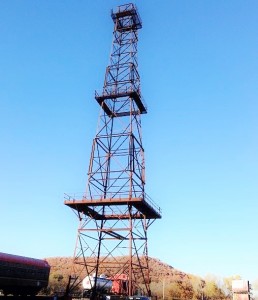
Dedicated during the 2007 Oklahoma centennial, a circa 1950s derrick commemorates the June 25, 1901, Red Fork oilfield discovery well. Photo courtesy Route 66 Historic Village.
After leasing thousands of acres in the Creek Nation, John S. Wick and Jesse A. Heydrick spudded their remote wildcat well near the village of Red Fork, across the Arkansas River from Tulsa. The attempt to find oil was not easy for the Pennsylvanians.
At the time, “Oklahoma Indian lands were in the process of being transferred from communal tribal ownership to individual tribal member holdings,” noted Bobby D. Weaver in a 2010 article for the Oklahoma Historical Society.

“This process, which made legal access to Indian property very uncertain, kept most oilmen away from areas under Indian control,” Weaver added. The well was almost never drilled when the St. Louis and San Francisco Railway station agent at Red Fork, “refused to accept a draft on their Pennsylvania backers to release their drilling equipment.”
Creek Land lease
The exploratory well was saved by a loan from two local doctors, John C. W. Bland and Fred S. Clinton. Drilling began at Red Fork on the tribal allotment of Sue A. Bland, a Creek citizen and wife of Dr. Bland.

Oil and natural gas exploration, production and service companies rushed to open offices in Tulsa following the 1901 oilfield discovery — and another in 1905.
Although the Sue A. Bland No. 1 well erupted an oil geyser high into the air, the discovery soon settled into production of just 10 barrels of oil a day from a depth of 537 feet. Despite the low production, the Oklahoma Territory well attracted a lot of national attention, drawing large numbers of exploration companies to the Tulsa area.
The Tulsa Democrat newspaper exclaimed, “Geyser of Oil Spouts at Red Fork” and “Oil Well Gusher Fifteen Feet High.” Within a week, Red Fork – once a quiet town of 75 people – was overrun by people clamoring for leases.
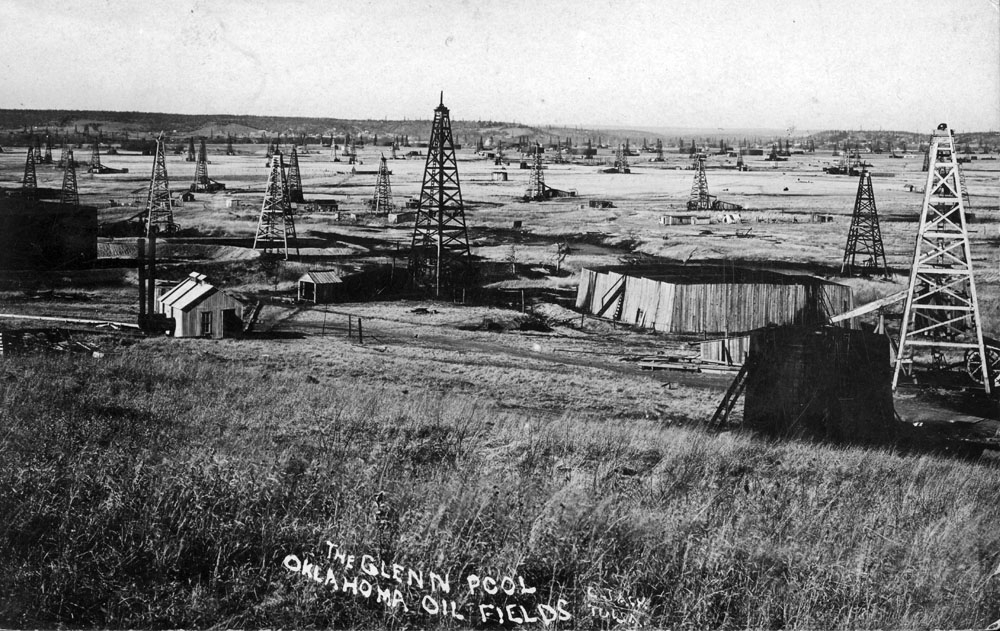
Tulsa County’s 1901 oilfield discovery was followed in 1905 by a well drilled deeper than the Red Fork production sands to reveal the far bigger Glenn Pool field (above in 1909). Photo courtesy Tulsa Historical Society & Museum.
Many of the newcomers settled in Tulsa, which in 1904 constructed its first bridge across the Arkansas River to accommodate wagonloads of oilfield workers and equipment.
“The Red Fork discovery never produced a great amount of oil, with most of the wells being in the fifty-barrel-per-day range, but it did produce excitement and drilling activity,” concluded Weaver.

“The discovery also prompted Tulsa citizens to begin a strong promotional campaign, with the result that by 1904 a much-needed bridge had been built across the Arkansas River,” he added. “This gave Tulsa access to the Red Fork Field and beyond and started that community on the road to becoming the predominant oil city in Oklahoma.”
The city’s petroleum industry future was assured in 1905 when a well drilled deeper than the Red Fork production sands revealed a truly massive oilfield. The Glenn Pool’s production far exceeded Tulsa County’s earlier Red Fork discovery.
Learn more in Making Tulsa the Oil Capital.
_______________________
Recommended Reading: Tulsa Oil Capital of the World, Images of America (2004); The Oklahoma Petroleum Industry
(2004); The Oklahoma Petroleum Industry (1980); Oil in Oklahoma
(1980); Oil in Oklahoma (1976). Your Amazon purchase benefits the American Oil & Gas Historical Society. As an Amazon Associate, AOGHS earns a commission from qualifying purchases.
(1976). Your Amazon purchase benefits the American Oil & Gas Historical Society. As an Amazon Associate, AOGHS earns a commission from qualifying purchases.
_______________________
The American Oil & Gas Historical Society (AOGHS) preserves U.S. petroleum history. Please become an AOGHS annual supporter and help maintain this energy education website and expand historical research. For more information, contact bawells@aoghs.org. Copyright © 2024 Bruce A. Wells. All rights reserved.
Citation Information: Article Title: “Red Fork Gusher.” Authors: B.A. Wells and K.L. Wells. Website Name: American Oil & Gas Historical Society. URL: https://aoghs.org/petroleum-pioneers/oklahoma-red-fork-oilfield. Last Updated: June 21, 2025. Original Published Date: June 23, 2014.
by Bruce Wells | Jun 16, 2025 | This Week in Petroleum History
June 16, 1903 – Ford Motor Company Incorporated –
After successfully testing his gasoline-powered Quadricycle in 1896, Henry Ford and a group of investors (including machinist John Dodge) filed articles of association for the Ford Motor Company. Ford’s contributions included machinery, drawings, and several patents. The first sale was a Ford Model A to a Chicago physician in July as the Detroit-based automaker began ordering carriages, wheels, and tires for a low-cost car that would become the Model T by 1908, according to the Henry Ford Heritage Association (HFHA).
June 18, 1889 – Standard Oil of New Jersey adds Indiana
Standard Oil Company of New Jersey incorporated a subsidiary, Standard Oil Company of Indiana, and began processing oil at its new refinery in Whiting, Indiana, southeast of Chicago. In 1910, the refinery added pipelines connecting it to Kansas and Oklahoma oilfields. When the Supreme Court mandated the break up of John D. Rockefeller’s empire in 1911, Standard Oil of Indiana emerged as an independent company. Amoco branded service stations arrived in the 1950s. Amoco merged with British Petroleum (BP) in 1998, the largest foreign takeover of a U.S. company at the time.
June 18, 1946 – Truman establishes National Petroleum Council
At the request of President Harry S. Truman, the Department of the Interior established the National Petroleum Council to make policy recommendations relating to oil and natural gas. Transferred to the new Department of Energy in 1977, the Council became a privately funded advisory committee with 200 members appointed by the Secretary of Energy. “The NPC does not concern itself with trade practices, nor does it engage in any of the usual trade association activities,” notes the NPC, which held its 134th meeting on April 23, 2024, in Washington, D.C.

June 18, 1948 – Service Company celebrates 100,000th Perforation
Fifteen years after its first well-perforation job, the Lane-Wells Company returned to the well at Montebello, California, to perform its 100,000th perforation. The return to Union Oil Company’s La Merced No. 17 well included a ceremony hosted by Walter Wells, chairman and company co-founder.
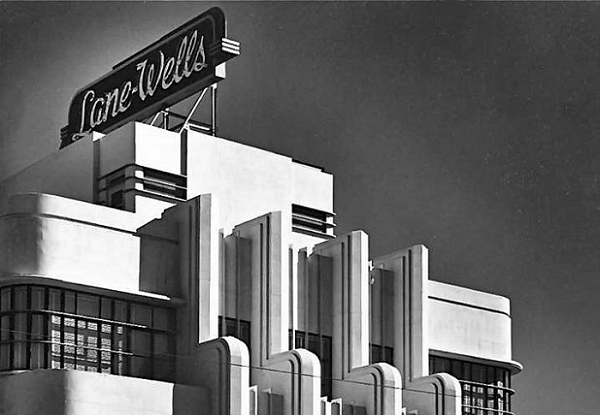
Los Angeles headquarters of Lane-Wells by architect William Mayer, completed in 1937. Photo courtesy Water and Power Associates.
In 1930, Wells and oilfield tool salesman Bill Lane developed a practical multiple-shot perforator that could shoot steel bullets through casing. After many tests, success came at the La Merced No. 17 well. By late 1935, Lane-Wells established a small fleet of trucks for well-perforation services. The company merged with Dresser Industries in 1956 and later became part of Baker-Atlas.
Learn more in Lane-Wells 100,000th Perforation.
June 20, 1977 – Oil begins Flowing in Trans-Alaska Pipeline
The Trans-Alaska Pipeline began carrying oil 800 miles from Prudhoe Bay to the Port of Valdez at Prince William Sound. The oil arrived 38 days later, culminating the world’s largest privately funded construction project. The Prudhoe Bay field had been discovered in 1968 by Atlantic Richfield and Exxon about 250 miles north of the Arctic Circle.
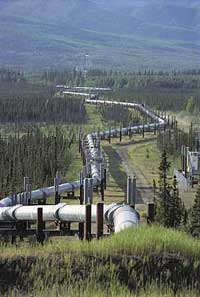
Construction of the controversial pipeline began in 1974. Photo courtesy Alaska Pipeline Authority.
After years of controversy, construction of the 48-inch-wide pipeline began in April 1974. Above-ground sections of the pipeline (420 miles) were built in a zigzag configuration to allow for expansion or contraction and include heat pipes. Oil throughput of the $8 billion pipeline peaked in 1988 at just over 2 million barrels per day, according to the Energy Information Administration (EIA), adding that since 2003, deliveries have been less than 1 million barrels per day and averaged a record low of 464,748 barrels per day in 2024.
“That creates challenges for the pipeline’s operators, including the formation of ice and the buildup of wax that is in the oil on the inside pipeline wall, EIA notes. “The amount of time it takes for oil to travel the 800 miles through the pipeline from the North Slope to the Valdez port increased from 4.5 days in 1988 to about 19 days in recent years.”
Learn more in Trans-Alaska Pipeline History.
June 21, 1893 – Submersible Pump Inventor born
Armais Arutunoff, inventor of the electric submersible pump for oil wells, was born to Armenian parents in Tiflis, Russia. He invented the world’s first electrical centrifugal submersible pump in 1916. At first, Arutunoff could not find financial support for his oilfield production technology after emigrating to the United States in 1923.

Russian engineer Armais Arutunoff, inventor of the first electric submersible pumps.
Thanks to help from Frank Phillips, president of Phillips Petroleum, Arutunoff moved to Bartlesville, Oklahoma, in 1928 and established a manufacturing company. The Tulsa World described the Arutunoff pump as “An electric motor with the proportions of a slim fencepost which stands on its head at the bottom of a well and kicks oil to the surface with its feet.”
REDA Pump Company manufactured pump and motor devices — and employed hundreds during the Great Depression. The name stands for Russian Electrical Dynamo of Arutunoff, the cable address of his first company in Germany and since 1998 a subsidiary of SLB (Schlumberger).
Learn more in Inventing the Electric Submersible Pump.

June 21, 1932 – Oklahoma Governor battles “Hot Oil”
Thirty National Guardsmen marched into the Oklahoma City oilfield when Governor William H. “Alfalfa Bill” Murray took control of oil production after creating a proration board despite objections from independent producers.

The Oklahoma History Center in Oklahoma City includes petroleum equipment on display in the Devon Energy Park, which opened in 2005. Photo by Bruce Wells.
Murray declared martial law again in March 1933 to enforce his regulations preventing the sale or transport of oil produced in excess of the quota, referred to as “hot oil.”
The state legislature passed a law in April giving the Oklahoma Corporation Commission authority to enforce its rules — taking away Murray’s power to regulate the petroleum industry. The commission had been established in 1907 to regulate railroad, telephone, and telegraph companies.
June 21, 1937 – “Great Karg Well” Marker dedicated in Ohio
Similar to the Indiana natural gas boom, discoveries in Ohio brought petroleum prosperity as evidenced by a 1937 historic marker at one well — “erected in humble pride by the people of Findlay, Ohio,” in celebration of the “Great Karg Well” that revealed a giant natural gas field in January 1886.
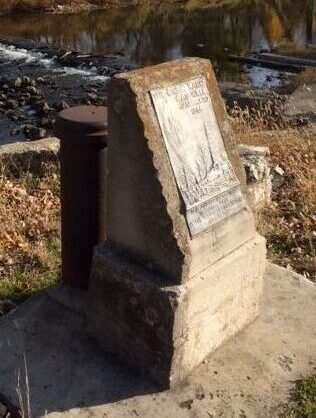
Marker dedicated in 1937 at the wellhead of the famous 1886 natural gas discovery at Findlay, Ohio. Photo by Michael Baker, courtesy Historical Marker Database.
“At that time gas was simply a by-product of oil drilling, and with no way to store it they ended up piping it away for free to heat homes and drive industrial machinery,” notes the historic marker inscription at the wellhead. Many companies promoted Ohio’s natural gas supplies, which “attracted glass companies from around the world” — until the gas ran out.
Learn more in Indiana Natural Gas Boom.
_______________________
Recommended Reading: From Here to Obscurity: An Illustrated History of the Model T Ford, 1909 – 1927 (1971); Standard Oil Company: The Rise and Fall of America’s Most Famous Monopoly
(1971); Standard Oil Company: The Rise and Fall of America’s Most Famous Monopoly (2016); The Prize: The Epic Quest for Oil, Money & Power
(2016); The Prize: The Epic Quest for Oil, Money & Power (2008); Wireline: A History of the Well Logging and Perforating Business in the Oil Fields
(2008); Wireline: A History of the Well Logging and Perforating Business in the Oil Fields (1990)
(1990) ; The Great Alaska Pipeline
; The Great Alaska Pipeline (1988); Artificial Lift-down Hole Pumping Systems
(1988); Artificial Lift-down Hole Pumping Systems (1984); Oil in Oklahoma
(1984); Oil in Oklahoma (1976); Ohio Oil and Gas, Images of America
(1976); Ohio Oil and Gas, Images of America (2008). Your Amazon purchase benefits the American Oil & Gas Historical Society. As an Amazon Associate, AOGHS earns a commission from qualifying purchases.
(2008). Your Amazon purchase benefits the American Oil & Gas Historical Society. As an Amazon Associate, AOGHS earns a commission from qualifying purchases.
_______________________
The American Oil & Gas Historical Society (AOGHS) preserves U.S. petroleum history. Please become an AOGHS annual supporter and help maintain this energy education website and expand historical research. For more information, contact bawells@aoghs.org. Copyright © 2025. Bruce A. Wells. All rights reserved.






(2009); Where it All Began: The story of the people and places where the oil & gas industry began: West Virginia and southeastern Ohio
(1994); Black Gold, Patterns in the Development of Wyoming’s Oil Industry (1997); Tulsa Where the Streets Were Paved With Gold – Images of America
(2000); Offshore Pioneers: Brown & Root and the History of Offshore Oil and Gas
(1997); Western Pennsylvania’s Oil Heritage
(2008); Oil and Gas Pipeline Fundamentals
(1993); Arizona Rocks & Minerals: A Field Guide to the Grand Canyon State
(2010). Your Amazon purchase benefits the American Oil & Gas Historical Society. As an Amazon Associate, AOGHS earns a commission from qualifying purchases.













